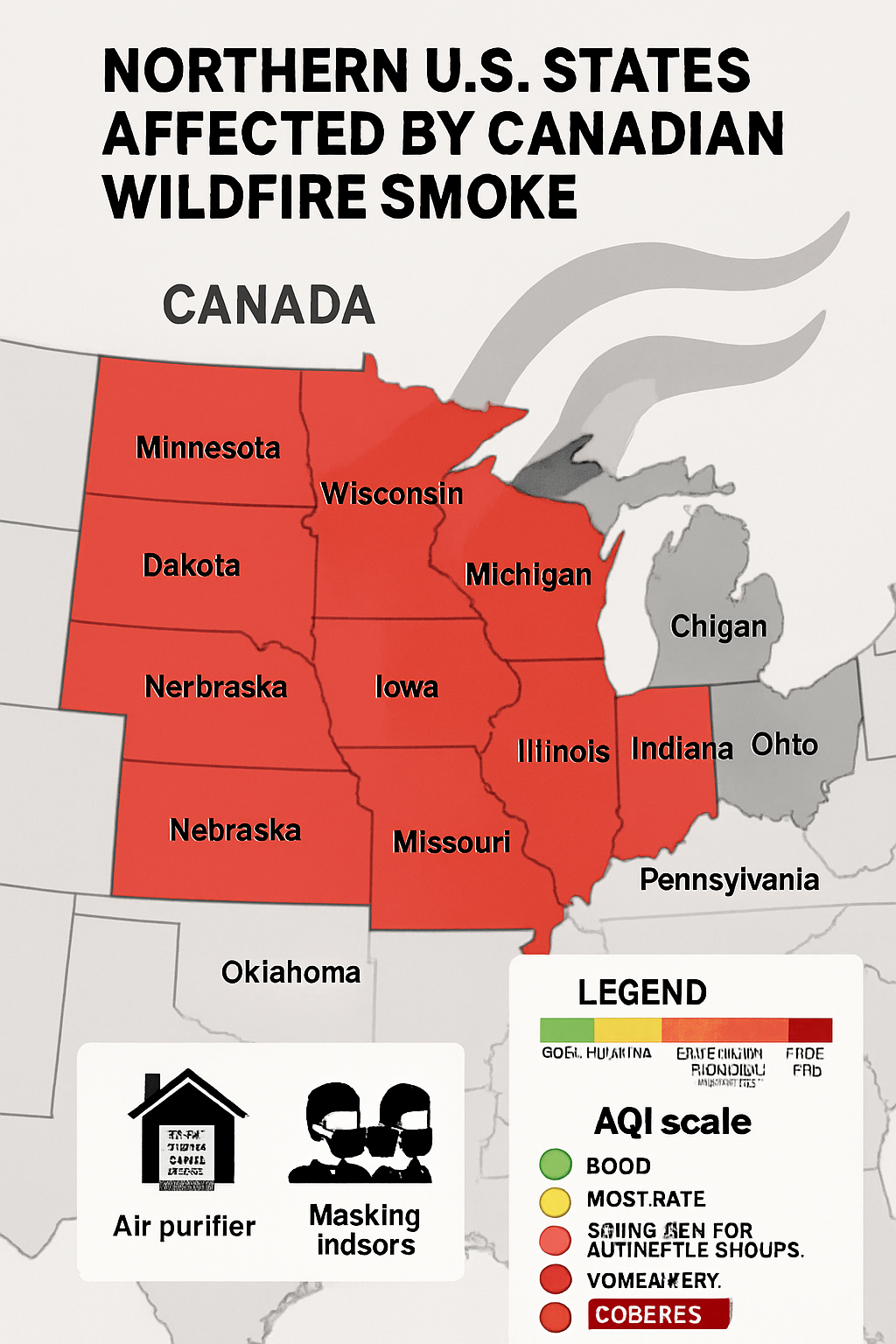A thick, persistent haze has settled over much of the northern United States, causing air quality to plunge from bad to hazardous. In states from Vermont and New York to Illinois and Michigan, officials have issued widespread Air Quality Health Advisories—a direct consequence of relentless Canadian wildfires. The big culprit? Dangerous levels of fine particulate matter (PM₂.₅), which is now pushing air quality into the “unhealthy” and even “code red” ranges for millions. timesofindia
If you live in the affected regions, understanding the risks—and taking smart precautions—is essential for your health and your loved ones.
Why Air Quality Is a Crisis Right Now
The Science Behind the Smoke
Canadian wildfires are burning with unusual intensity and duration in 2025, sending vast plumes of smoke south across the border. Winds are carrying this smoke into the U.S., where it mingles with local air, triggering surges in PM₂.₅—tiny airborne particles under 2.5 microns across. washingtonpost
Why PM₂.₅ is the health risk:
- These particles are about 1/30th the width of a human hair.
- They can penetrate deep into lung tissue and enter the bloodstream.
- Short-term exposure aggravates asthma, heart conditions, or respiratory illness, and raises risk of ER visits and hospitalization.
- Long-term exposure increases risks for heart attack, stroke, and lung cancer.
Health Advisors: Who’s at Highest Risk?
- Children: Faster breathing rates and developing lungs make them vulnerable.
- Seniors: Age-related changes in lung and heart function elevate risk.
- People with asthma, COPD, or heart disease: Any increase in air pollution can worsen symptoms, sometimes severely.
“Code Red” and Unhealthy Levels Explained
- Air Quality Index (AQI): Index that converts pollutant concentrations into easy-to-understand categories.
- Code Red: AQI 151–200. Unhealthy for everyone; sensitive groups at higher risk. Limit all outdoor activity.
- Code Orange: AQI 101–150. Unhealthy for sensitive groups.
Widespread advisories now urge all residents in affected states to be proactive in protecting their health.
Which States Are Impacted?
As of August 2025, air quality advisories are in effect across:
- Vermont
- New York
- Wisconsin
- Michigan
- Illinois
- New Hampshire
- Maine
Conditions can vary daily—always check your local AQI before heading outside.
What Should You Do During a Code Red Air Quality Advisory?
If you’re in an affected region, follow these evidence-backed precautions:
Stay Indoors
- Limit all outdoor activities, especially exercise and strenuous work.
- Create “clean air rooms” at home or work using air conditioning or HEPA filtrations.
Use Air Filtration
- Run certified air purifiers in living and sleeping areas.
- Use HVAC systems on recirculate mode.
- Close windows and doors to avoid bringing in smoky air.
Protect Vulnerable Populations
- Keep children indoors as much as possible.
- Check in on elderly neighbors and those with chronic health conditions.
- Schools and daycares should keep outdoor recess or classes to a minimum.
Plan Breathing Breaks
- If you must go outside, wear an N95 or better respirator mask designed to filter fine particles.
- Avoid high-traffic streets and busy roads, where air quality is even worse.
Monitor Symptoms
- Watch for coughing, shortness of breath, irregular heartbeat, wheezing, or chest tightness.
- Seek immediate medical attention for severe or persistent symptoms.
How Long Will These Hazards Last?
Forecasts depend on wildfire activity, wind direction, and precipitation. While rain can temporarily clear the air, as long as Canadian wildfires rage, new smoke plumes may continue to flow south. Air quality updates are issued daily, sometimes even hourly.
Why Is This Happening More Often?
- Climate change is fueling hotter, drier summers—making wildfires in Canada and western U.S. both larger and more frequent.
- Wind patterns can carry smoke hundreds or thousands of miles.
- Urban impacts: Dense city populations amplify the health toll of regional smoke events.
FAQs
Can I protect myself indoors without an air purifier?
Yes! Use AC on recirculation, seal leaky windows and doors with towels, and avoid burning candles or using gas stoves, which add indoor pollution.
Are masks effective against wildfire smoke?
N95 or P100 masks can filter fine PM₂.₅ particles; cloth/surgical masks do NOT protect against wildfire smoke.
Is it safe to exercise outdoors during an AQI advisory?
No. High exertion increases inhalation of dangerous particles. Wait until levels drop before resuming outdoor activities.
Do these advisories apply to rural as well as urban areas?
Yes. Airborne PM₂.₅ respects no boundaries and can blanket whole regions.
What This Means for Families & Communities
- Check reliable sources: Use EPA’s AirNow, your state Department of Health, or local news for updated AQI and guidance.
- Rethink routines: Plan errands, commutes, or outdoor sports for times when the AQI dips to safer levels.
- Advocate for solutions: Support policies on forest management, wildfire reduction, and emissions control—today’s hazards are tomorrow’s call for sustainability.
Takeaway: Indoor Precautions Are Now Essential
Widespread “code red” advisories make one thing clear: smoke from Canada’s wildfires isn’t just a distant problem. It’s a direct, pressing threat to the everyday health of millions across northern U.S. states. Staying indoors, using filtration, and tracking air quality updates are no longer optional—they’re crucial steps for every family. Let’s act today to protect ourselves, and push for climate action to safeguard tomorrow.









+ There are no comments
Add yours